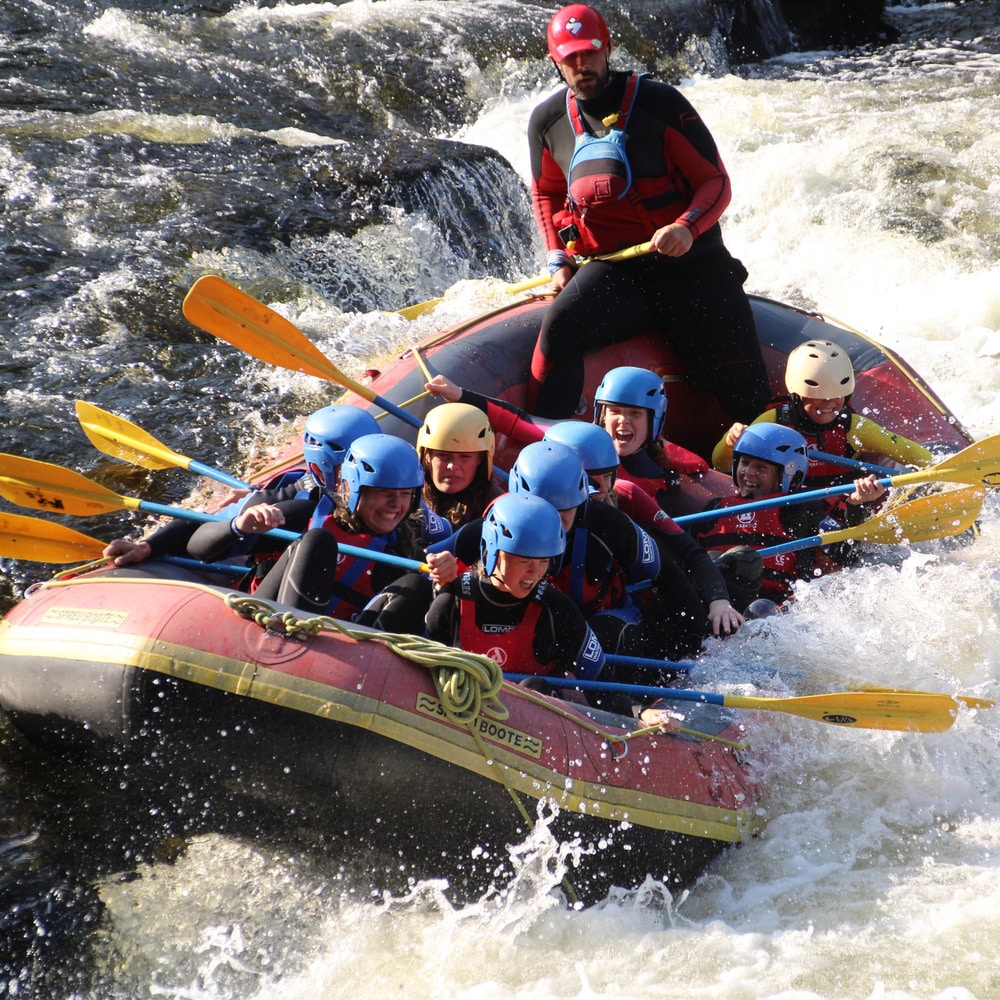There’s something undeniably special about learning beyond the classroom. When students swap textbooks for paddles and timetables for tides, they open themselves up to new challenges, new friendships and new sides of themselves they didn’t know existed. Watersports are more than just a fun way to spend outdoors, they’re powerful, transformative experiences that can boost confidence, encourage teamwork and support wellbeing.
Did you know that swimming and water activities are one of the top activities students want to take part in, at a staggering 41%! Whether it’s a residential trip or a day of activities by the lake, introducing students to the world of water can support their physical health, mental wellbeing and social development. From paddling a canoe to building a raft as a team, watersports offer endless opportunities to engage and inspire young people.
What are the benefits of water sport activities for students?
Watersports offer a rich combination of physical, mental, and social benefits for children and young people. They’re just as engaging as they are deeply developmental, providing opportunities for students to challenge themselves in ways that are often very different from traditional classroom or sports settings.
From building physical strength and coordination to nurturing confidence and resilience, these activities create unique learning experiences outside the usual school environment. Watersports can help students discover new skills, learn to work as a team, and develop a sense of adventure and independence. Whether they’re paddling across a lake, balancing on a paddleboard, or working together to construct a raft, students are constantly growing not just as athletes but as individuals.
1. Physical health and coordination
Watersports provide full-body workouts that help promote:
- Strength and stamina
- Balance and agility
- Coordination and reaction time
Activities like kayaking and paddleboarding improve core strength and balance, while canoeing and raft building work the upper body muscles and demand fine motor control. For many students, it’s exercise disguised as fun, far more engaging than the average PE lesson.
The NHS recommends at least 60 minutes of physical activity per day for young people. Watersports can easily contribute to this, and for many children.
2. Mental wellbeing
Being close to water has been shown to reduce signs of stress and anxiety. According to the Blue Health Project, time spent near water can positively affect our mental well-being. For students, this means:
- Reduced stress and mental fatigue
- Improved mood and focus
- Boosted self-esteem
The steady, rhythmic motion of paddling or the gentle resistance of water during a swim can feel almost meditative, helping students clear their minds and feel calmer. This is especially important today, as many young people spend more time on screens and less time in nature. Watersports give them space to switch off, reset, and build emotional resilience in a way that few other activities can.
3. Social development and teamwork
Most water sports involve working together. Whether students are working in pairs to help steer a canoe or teaming up to build a raft, they’re constantly:
- Practising communication skills, like discussing the best way to balance the raft, deciding who will paddle where, and agreeing on a plan if something doesn’t go to plan
- Building trust and cooperation as they rely on each other to stay safe and achieve their goals
- Learning how to lead and follow, taking turns to guide the group or support their teammates
These interactions support empathy and emotional intelligence, skills that carry over into the classroom and beyond. Students also learn to adapt to each other’s strengths, which is vital when working on academic group projects or collaborating in future workplaces.
4. Trying something new and discovering hidden talents
One of the joys of watersports is how unfamiliar they are to most students. This creates a level playing field where everyone has the chance to explore without pre-existing expectations or labels. In these completely new environments, hidden skills often shine through.
You might see:
- The quietest student become a natural at kayaking, surprising themselves and their peers
- Someone who struggles in traditional sports show great coordination and confidence while windsurfing
- A student who usually hangs back in PE take the lead when organising a canoeing challenge
- Young people who find it hard to focus in the classroom concentrate fully while learning to sail
These moments are invaluable for building confidence, self-esteem, and a stronger sense of identity that stays with them long after the activity ends.
How watersports support students’ personal growth and confidence
Watersports provide the perfect setting for personal development. There’s a challenge, but also safety. Risk, but also support. It’s this combination that makes water activities so effective for building confidence and character.
Unlike traditional classroom or sports environments where some students may already have established roles or reputations, watersports offer a fresh start. Everyone is out of their comfort zone together, which helps level the playing field and encourages students to try something new without fear of judgement.
In this kind of setting, students can push their boundaries, discover new strengths, and develop a stronger sense of self. Whether it’s building resilience through new challenges, learning to work as a team on the water, or simply feeling more confident in themselves, watersports provide a unique and powerful opportunity for growth.
Building resilience and stepping outside of their comfort zone
Facing a new challenge, like standing up on a paddleboard or jumping into a lake, can be daunting. But once students try, they often surprise themselves. That feeling of “I didn’t think I could do it, but I did” is powerful.
Overcoming these small fears builds resilience and shows students that confidence isn’t about being fearless; it’s about giving things a go.
For students who might lack confidence in academic settings, outdoor learning offers a new arena to shine.
Developing communication and leadership skills
Team-based watersports encourage your students to take the lead, offer encouragement and negotiate roles, all crucial skills for future success.
Through activities like paddling a canoe or coordinating a sailing manoeuvre, students learn the value of effective communication, cooperation, and trust.
Expands sporting opportunities
There’s no doubt that your school provides amazing sporting opportunities for students, but it’s difficult to give any kind of water sports without the facilities or natural resources! And that’s why a watersports adventure is so good, because students can try a whole host of new watersports that they’ve never tried before.
Each water sport requires different skills and techniques, from the balance needed for paddleboarding to the teamwork essential for sailing. Sometimes talents are discovered in the most unusual ways. Maybe your students will uncover a new talent after taking part in water sports activities at PGL.
It could ignite a love for a new hobby
Not everyone has the chance to try out thrilling water sports activities, but once students have tried them out, there’s a high chance that some of them will have found a new hobby. It’s great for encouraging your students to be physically active at home! Plus, it’s a great feeling to know you’ve helped inspire them to take up a new hobby.
Increase confidence in the water
Whether students get fully invested in water sports activities or prefer to test the waters first, it’s all a learning curve. At PGL, we encourage students to do what makes them feel comfortable under the guidance of our skilled instructors, so if they prefer to take part gradually in our water-based activities, then we’ll support them.
Because gaining confidence in the water is gradual, we want to help them achieve as much confidence as possible. Learning watersports also teaches essential water safety skills. Students learn how to navigate different water conditions, understand the importance of wearing life jackets, and practice techniques for staying safe in the water.
It’s also brilliant for the already confident swimmers! They can splash around as much as they’d like in our challenges and further develop their skills and confidence in the water.
Develops life skills
A watersports adventure also helps boost some valuable life skills, especially at PGL. Through activities like paddling a canoe or coordinating a sailing manoeuvre, students learn the value of effective communication, cooperation, and trust, which are transferable to the classroom. We also have creative water-based challenges where working as a team is the key to success, and other team games where leadership is required to guide the rest of the group to victory!
Watersports activities available at PGL
We offer a wide range of watersports tailored to different ages, abilities, and interests. Whether it’s a student’s first time on the water or they’ve had previous experience, our instructor-led sessions ensure everyone is supported, included, and having fun.
Here are just some of the watersports activities available at selected centres your students can try on a PGL adventure:

A calm and classic activity ideal for building teamwork and coordination. Students learn basic paddling techniques and how to steer with a partner.
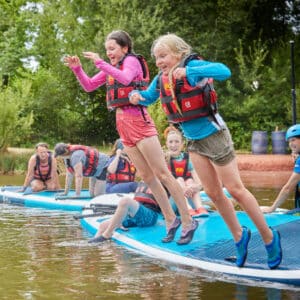
A fun test of balance and resilience-often leading to lots of giggles and teamwork as students try to stay upright!
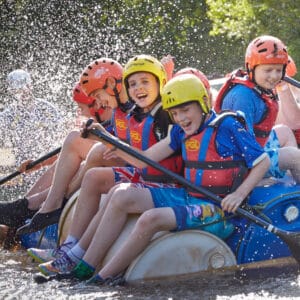
A brilliant blend of teamwork, creativity, and problem-solving. Students use barrels, ropes, and logs to build a floatable raft—and then test it out on the water.
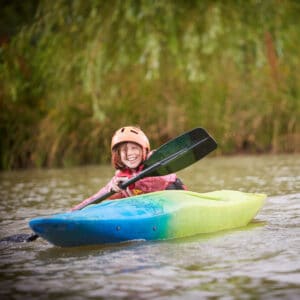
A step up in challenge, kayaking builds coordination and upper-body strength. It also gives students a strong sense of independence.

An inflatable water obstacle course is great for younger students or as a high-energy reward at the end of a trip.
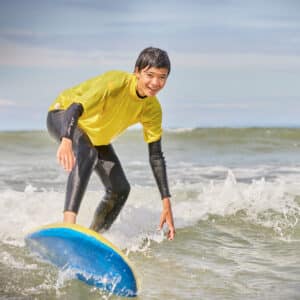
At coastal centres, students can experience the thrill of catching a wave. These activities offer adrenaline, excitement, and a massive sense of achievement.

A more advanced option for older groups or students looking to push themselves further. Strategy, cooperation, and calm under pressure are key.
How watersports support the REACH framework
PGL’s approach to learning is rooted in our REACH framework, which supports five key pillars of personal development:
- Relationships
- Experiences
- Abilities
- Character
- Health & Wellbeing
Watersports are particularly effective at addressing all five:
Relationships
Working in pairs or teams encourages students to support one another, communicate clearly, and resolve differences constructively.
Experiences
Trying something new, new-especially outdoors, broadens students’ horizons. For some, it might be their first time on water.
Abilities
From paddling to problem-solving, watersports help students develop both physical and social skills.
Character
There’s no better setting to build resilience, grit, and integrity than out on the water, where students must adapt to changing conditions and support one another.
Health & Wellbeing
Watersports combine physical activity with exposure to nature, both of which are proven to improve mental health.
What to expect on a watersports trip with PGL
We know that safety, structure, and support are key. Here’s what you can expect when you bring your students to PGL for a watersports adventure:
- Qualified instructors trained in safety, first aid, and group management
- All equipment provided, including life jackets and wetsuits where needed
- Tailored sessions based on your group’s age and ability
- Structured activities with clear learning outcomes
- Risk assessments and support documents for group leaders
- Flexible programmes that balance watersports with land-based activities and downtime
Join PGL for some outdoor learning activities!
How great are watersports for children? If you’re interested in watersports trips for schools, then why not take a look at our watersports and adventure in France for secondary schools! If you’re looking to stay in the UK, then our residential school trips also feature many other watersports activities for students. We have centres in the Isle of Wight, Dorset, Suffolk, Devon and many more!
They offer students an experience they’ll never forget! Life at PGL is about adventure, fun and laughter! With fantastic group activities galore, your students will never tire of the wide range of adrenaline-fuelled challenges and amazing activities into the evening too.
We provide a wide range of school trips for primary schools and secondary schools that are all about outdoor education!
At PGL, we have an exceptional offering of trips, locations and activities to enjoy, so get in touch today to discuss your next school trip.
